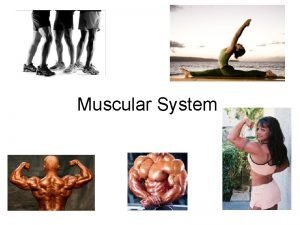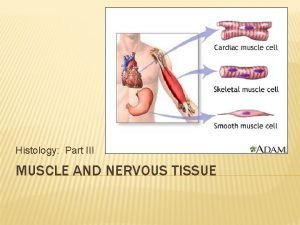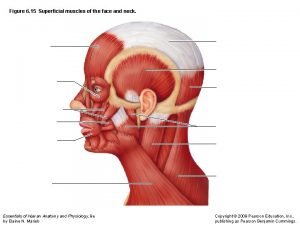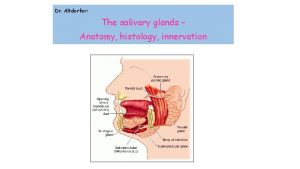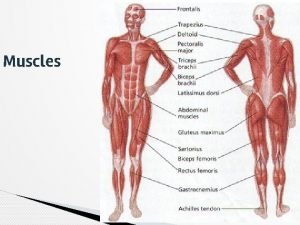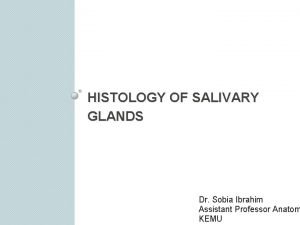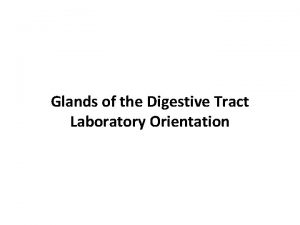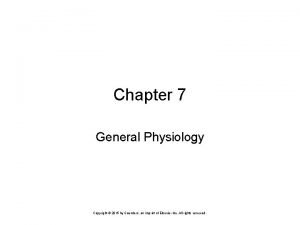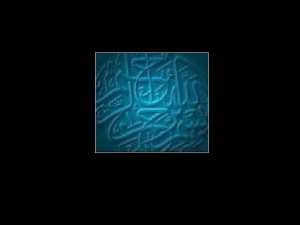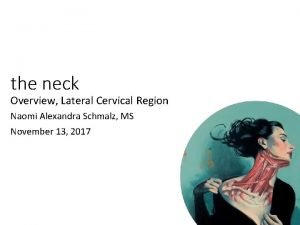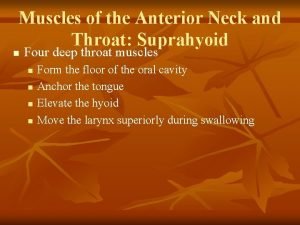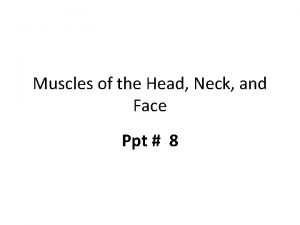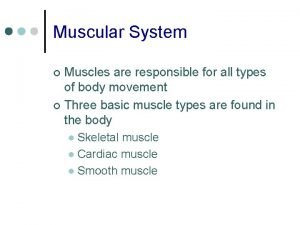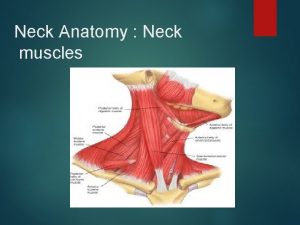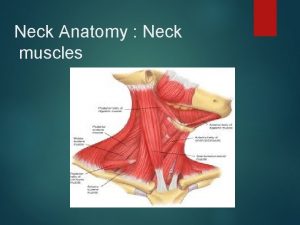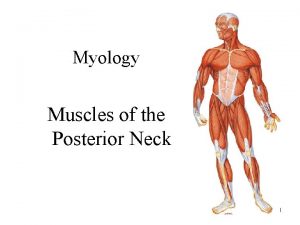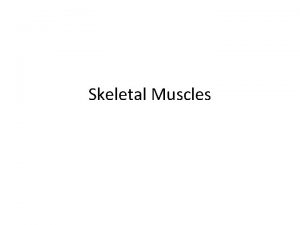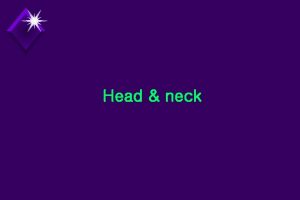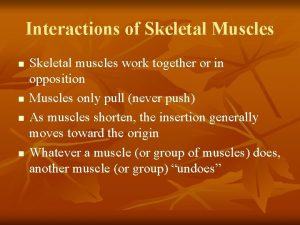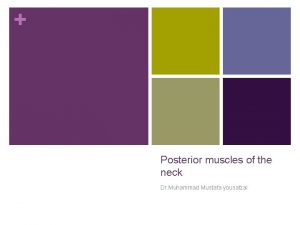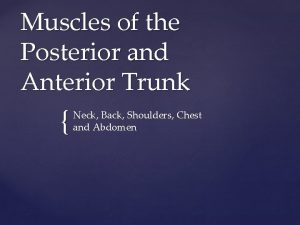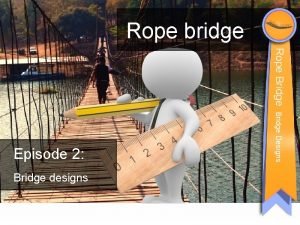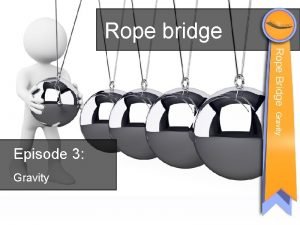Posterior neck muscles Reminder muscles Skeletal striated Rope















- Slides: 15

Posterior neck muscles

Reminder muscles • Skeletal striated • Rope! – Epimysium – whole muscle – Perimysium – bundles of fibres – Endomysium –muscle fibre • Myofilaments – Thin/actin – Thick/myosin • Sarcomere – NB this bit shortens completely, depending on strength of contraction required depends on how many • Muscle contraction – Isotonic – movement • Concentric - shorter • Eccentric - longer – Isometric – no movement • same length

Reminder Muscles continued • Types of fibre - NB all muscles a mixture of fibres – Type I – slow twitch – predominant in postural muscles • – • Red -high myoglobin, High ATP generation, Slower ATP use, Resistant to fatigue Type II – fast twitch – faster contraction, fatigue more quickly • Type IIA – red, high ATP generation, high ATP use (infrequent) • Type IIB – white, lower ATP generation (anaerobic), fast ATP use Muscle Tone - State of resting tension in a muscle – maintain posture, balance and prepares for action/response to danger e. g. pull on muscle increases • Maintained by muscle spindles and golgi tendon organs • Low tone/hypotonia – flaccidity, reduced stretch reflex • High tone/hypertonia – increased stretch reflex • – Spasticity – velocity dependent resistance – Rigidity – velocity independent • Cogwheel – jerky resistance • Lead pipe – same throughout Butter!!!

Reminder of joints in the neck • Atlanto-occipital • !st class lever – fulcrum between effort and load • Atlantoaxial • Facets • Intervertebral discs

Function Nodding head • takes place predominantly through flexion and extension at the atlanto-occipital joint. However, the cervical spine is comparatively mobile, and some component of this movement is due to flexion and extension of the vertebral column itself. Shaking head • The movement rotating the head left and right happens almost entirely at the atlanto-axial joint. A small amount of rotation of the vertebral column itself contributes to the movement.

Neck muscles • Back muscles stabilize and move vertebral column and are grouped according to length and direction • Posterior – Superficial – Deep • Lateral – Superficial – Deep • Anterior – Superficial – Deep

Suboccipital muscles • • Rectus capitis posterior major – Spinous process axis to occiput nuchal line – Extension ipsilateral rotation Rectus capitis posterior minor – Tubercle posterior arch atlas occiput medial nuchal line – Extension ipsilateral rotation Obliquus capitis inferior – Spine axis to transverse process atlas – Rotation ipsilateral Obliquus capitis superior – Transverese process atlas to occiput superior and inferior nuchal line – Extension lateral flexion

Segmental muscles • At all levels • Connect processes of adjacent vertebrae • Interspinales – spinous processes • Anterior and posterior intertransversarii – transverse processes

Muscles – erector spinae, semispinalis, multifidus

Transversospinales muscles • They are at all levels in the back • Cross a few segments • Semispinalis muscles – Run from transverse processes to spinous processes of more superior vertebrae – involved in rotation and extension of vertebral column. – Semispinalis capitis • – Semispinalis cervicis • – • transverse processes of upper thoracic vertebrae to spinous processes of C 1 -C 5 Semispinalis thoracis • • transverse processes of upper thoracic and lower cervical vertebrae to occiput between superior and inferior nuchal line transverse processes of vertebrae T 6 -T 10 to spinous processes of vertebrae C 6 -T 4. Multifidus – Cervical, thoracic and lumbar – Bridge 3 -6 levels transverse to spinous process – Action – bilateral extension, unilateral side flexion and contralateral rotation Rotatores cervicis (thoracis and lumborum) – transverse processes of inferior vertebrae to the laminae and transverse processes of the vertebrae 1 -2 levels above.

Erector Spinae • Majority of the muscle mass of the back at all levels • Cross many segmental levels • Actions – Primary extensor of the vertebral column – Controls flexion, lateral flexion, and rotation (maintains lumbar curve) • Comprises 3 groups – Iliocostalis (laterally placed) group • Iliocostalis cervicis, thoracis, lumborum – Longissimus (intermediately placed) group • Longisimus capitis, cervicis, thoracis – Spinalis (medially placed) group. • Spinalis capitis, cervicis, thoracis

Muscles – erector spinae, semispinalis, multifidus

Superficial • Splenius muscles originate at midline and run laterally and superiorly • Action – extension, lateral flexion, rotation – Splenius capitis • Spinus process C 5 -T 3 to mastoid process temporal bone – Splenius cervicis • Spinus processes T 3 -T 6 to

Poor head position • Domino effect • Head comes forward – Centre of gravity forward • Upper body drifts back – To Compensate • The pelvis tilts forward – To compensate • Poor head position causes problems with all levels of the back (and body)

Problem with poor head position • NB head 8. 2% body weight – 11 st/70 kg person head weighs 12. 5 lbs/5. 75 kg – Weight of a 3 month old baby! (Awake? !? ) • Every 1 inch forwards add 12 lb weight!!!
 Striated muscles
Striated muscles Which type of muscle is non-striated and involuntary
Which type of muscle is non-striated and involuntary Muscles of the anterior torso
Muscles of the anterior torso Nidus parotideus
Nidus parotideus Striated triceps
Striated triceps Which type of muscle is non-striated and involuntary
Which type of muscle is non-striated and involuntary Serous vs mucous glands
Serous vs mucous glands Liver central vein
Liver central vein Which muscle is striated in appearance but resembles smooth
Which muscle is striated in appearance but resembles smooth Posterior triangle of neck
Posterior triangle of neck Cervical plexus
Cervical plexus Root of neck
Root of neck Neck shoulder muscles
Neck shoulder muscles Musculos
Musculos Facial muscles ppt
Facial muscles ppt Pectoral girdle muscles
Pectoral girdle muscles
